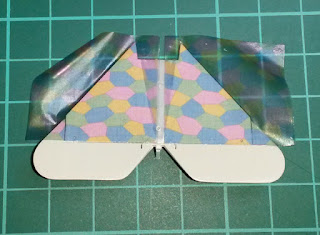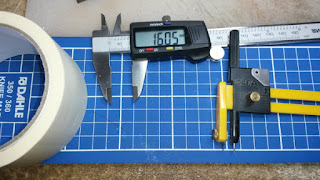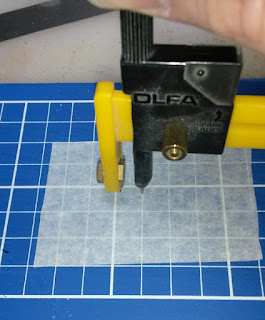I'm reaching the end of the decalling phase (more or less) as I put the white trim on the fuselage and tail plane and started applying the woodgrain decal on the wing, I've never used so much Kleer on a model as I have on this one. The white on the tailplane will need to be trimmed as it's a bit of a mess also I'll need to mask it off and airbrush some white over the top as the decal does'nt cover the leading and trailing edges;
One of the problems I had was repairing the lozenge in places where I had cut a little too much off. I tried patching the areas with off-cuts of lozenge but in the end I mixed up various Vallejo and Andrea paints and touched up the areas instead.
Once the wing has been covered in wood grain it will be matt varnished and then painted in a streaky finish using oil paint. I might have to replace the panel on the port side as I had a bit of trouble getting it down smoothly (my fault) and I suspect there may be air trapped underneath which will lead to the decal 'silvering' after varnishing.
Hi and welcome to my small corner of the internet and here you will find a variety of models that mainly comprises armour, aircraft and figures. I'll be adding pics of current projects and older stuff plus models that have appeared in a couple of magazines, Model Military International and Military Miniatures in Review. Thank you for stopping by and taking an interest in my work.
Monday 30 May 2016
Saturday 28 May 2016
Dragon Fokker E.V/ D.VIII
The lozenge requires rib tapes on the tailplane and Aviattic state in the instructions that their decal is not really suitable for cutting into 1mm wide strips. What I *should* have done is use white decal paper cut into strips and put into place on the ribs first THEN put the lozenge over it, however me being me I did'nt give it a thought.
I got onto Hannants website for 1/48 lozenge and there were a few types available so I opted for some by HGW and Techmod which duly arrived today. The HGW decals are transparent just like Aviattic so I'll use these for another project, this left the Techmod ones and OMG they are FRAGILE! Cutting them into 1mm strips actually saw the decal leaving the backing sheet BEFORE I put them anywhere near water...not good! Anyway I managed to get some strips cut and applied to the ribs on the underside and even with them breaking in places they look rather good even if I say so myself;
I'm pleased with that result!
The rest of the fuselage was decalled and this is where I'm up to at the moment;
When dry the decals will be trimmed using a brand-new scalpel blade, again the lozenge on the upper tailplane has been applied chord-wise and when dry the elevators will be covered span-wise.
The next job will be to apply Uschi Van Der Rosten wood-grain decal to the main wing as this will be finished with a streaky effect over the wood as per the real aircraft.
Panzer, Tank, Aircraft,
1/48 Fokker E.V/D.VIII,
Aviattic,
Aviattic lozenge,
Dragon Fokker E.V/D.VIII,
Fokker E.V/D.VIII
Wednesday 25 May 2016
Dragon Fokker E.V/ D.VIII
The overlap on the fuselage underside was trimmed but I think for the fuselage sides I will use the kit decals as templates as the Aviattic stuff is VERY difficult to trim cleanly, even using a brand new scalpel. The lozenge was applied chord-wise on the tailplane and span-wise on the elevators as per the practice of the time. I deliberately tried to get a mismatch on the fuselage seam as this is where the fabric was sewn together but it did'nt really work out.
Whatever undercoat you use for the decals it has to be flawless as I'm finding out, there may be small air bubbles underneath even with using Kleer but it's all part of the learning process and the Aviattic decals are VERY good.
Panzer, Tank, Aircraft,
1/48 Fokker E.V/D.VIII,
Dragon Fokker E.V/D.VIII,
Fokker E.V/D.VIII
Tuesday 24 May 2016
Revell Leopard I
After spraying a coat of Tamiya X-22 Clear a week or so ago I started the weathering process on this today with a pin wash of dark brown. I know it's 'product placement' but I like the Mig stuff although I'm going to start making my own as it's just not dark enough, especially on dark vehicles like this Leopard.
Anyway the wash was run into all the nooks and crannies, gaps, engine deck mesh and wheels with the excess removed with odourless thinners;
I gloss varnish models for this as I get better control of the wash as on a matt surface I find it leaves 'tide-marks' which are very hard to blend in (the SS-23 was REALLY bad for it), also the gloss helps with the decals bedding down without air getting trapped underneath them.
Once the wash has dried I'll add some rain marks and some other washes then the model will be matt varnished.
A word about the markings is needed here as Revell had this one down as a Batch 1 Leopard with the rectangular telephone box on the rear hull plate but after looking in the Tankograd book it was actually a Batch 2 Leopard with the round telephone box so luckily for me I did'nt have to go huntng for another decal sheet.
Anyway the wash was run into all the nooks and crannies, gaps, engine deck mesh and wheels with the excess removed with odourless thinners;
I gloss varnish models for this as I get better control of the wash as on a matt surface I find it leaves 'tide-marks' which are very hard to blend in (the SS-23 was REALLY bad for it), also the gloss helps with the decals bedding down without air getting trapped underneath them.
Once the wash has dried I'll add some rain marks and some other washes then the model will be matt varnished.
A word about the markings is needed here as Revell had this one down as a Batch 1 Leopard with the rectangular telephone box on the rear hull plate but after looking in the Tankograd book it was actually a Batch 2 Leopard with the round telephone box so luckily for me I did'nt have to go huntng for another decal sheet.
Panzer, Tank, Aircraft,
1/35 Leopard I,
1/35 Revell Leopard I
Saturday 14 May 2016
Fokker E.V/ D.VIII cockpit finished
I'm calling the cockpit on this done so I should be able to get the fuselage glued together and make some progress on the rest of the model;
The rear panel and seat were covered in Aviattics' exterior lozenge decal with the seat bottom done with Uschi Van Der Rosten woodgrain. The seat belts were two layers of masking tape cut into 1.5mm strips and the buckles were cut from the etched belts in the kit.
The rudder pedals are supposed to be at that angle as the rudder will be offset to starboard. The faces for the compass and tachometer actually came from an old 1/72 Airfix Canberra decal sheet which were cut out using a 1.4mm round punch.
The rear panel and seat were covered in Aviattics' exterior lozenge decal with the seat bottom done with Uschi Van Der Rosten woodgrain. The seat belts were two layers of masking tape cut into 1.5mm strips and the buckles were cut from the etched belts in the kit.
The rudder pedals are supposed to be at that angle as the rudder will be offset to starboard. The faces for the compass and tachometer actually came from an old 1/72 Airfix Canberra decal sheet which were cut out using a 1.4mm round punch.
Panzer, Tank, Aircraft,
1/48 Fokker E.V/D.VIII,
Dragon Fokker E.V/D.VIII,
Fokker E.V/D.VIII
Saturday 7 May 2016
Fokker E.V/D.VIII update
The weave pattern in it is amazing! I can't wait to do the fuselage exterior.
Uschi VDR wood grain is pretty damned good too;
Now that the interior has been matted down I can now get on with finishing it before gluing the fuselage together.
Friday 6 May 2016
Masking road wheels
While there are some handy hints and tips going around at the moment, here's one from me regarding the masking of roadwheels on tanks. Some of you (yes YOU) spend a fortune on wheel masks from aftermarket manufacturers especially if you make a lot of tanks, trucks etc so here's my method of doing them.
First of all for the price of a couple of masking sets you can purchase a digital vernier (or caliper), a compass cutter, masking tape and a cutting mat. You may think that a digital vernier is a hideously expensive item but the one I have was purchased from Aldi for the princely sum of £10 and before you say "for that price it must be crap" I have had this vernier calibrated for work in the aerospace industry (I will admit the calibration guy was surprised but hey), anyway the compass cutter is not that expensive either so getting these two will save you money later on;
Using the vernier measure the roadwheel across the diameter of the rim;
Put some masking tape on the cutting mat then using the measurement from the vernier set the compass cutter to the radius of the meaurement (which is half the diameter) and cut a circle;
Cut the tape into a square section;
Then apply to the roadwheel;
Once painted remove the mask and you should have a perfectly painted roadwheel!
It's as easy as that and will save you money over time. By the way don't forget to mask the rear!
Using the vernier measure the roadwheel across the diameter of the rim;
Put some masking tape on the cutting mat then using the measurement from the vernier set the compass cutter to the radius of the meaurement (which is half the diameter) and cut a circle;
Cut the tape into a square section;
Then apply to the roadwheel;
Once painted remove the mask and you should have a perfectly painted roadwheel!
It's as easy as that and will save you money over time. By the way don't forget to mask the rear!
Revell Leopard base coated
Today I managed to get some paint on the Leopard using my brand spanking Iwata Neo TRN2 that I got for my birthday in January but only now have I had a chance to use it. For a first outing I have to say I'm impressed, usually I spray with an Iwata Revolutin CR but for large areas it takes forever so this new airbrush is perfect.
I primed the Leopard with Games Workshop Chaos Black a few days ago and today it got a coat of Tamiya XF-65 Field Grey with some XF-1 Black thrown in. When the base-coat was done I made another mix of Field Grey but this time I threw some XF-58 Olive Green in to lighten it a bit and sprayed in between panels, sticky out bits etc for a bit of contrast to an otherwise drab scheme. The model will get a coat of X-22 Clear next after which any decals will be applied then I can start the weathering.
The colour may be a bit light for a late 1960's/early 70's Bundeswehr tank but the varnish will darken the paint as will any weathering.
Edit; The model was glossed not long after and looks very shiny now;
I primed the Leopard with Games Workshop Chaos Black a few days ago and today it got a coat of Tamiya XF-65 Field Grey with some XF-1 Black thrown in. When the base-coat was done I made another mix of Field Grey but this time I threw some XF-58 Olive Green in to lighten it a bit and sprayed in between panels, sticky out bits etc for a bit of contrast to an otherwise drab scheme. The model will get a coat of X-22 Clear next after which any decals will be applied then I can start the weathering.
The colour may be a bit light for a late 1960's/early 70's Bundeswehr tank but the varnish will darken the paint as will any weathering.
Edit; The model was glossed not long after and looks very shiny now;
Panzer, Tank, Aircraft,
1/35 Leopard I,
1/35 Revell Leopard I
Subscribe to:
Posts (Atom)






















